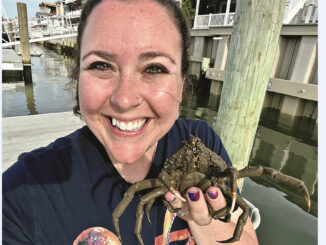
Sea Stars
By Kathy KrankingSure, with their bright, beautiful colors, sea stars are super showy. But that’s not the only super thing about them.
Consider this: Sea stars can walk up walls without falling! They can attack and eat animals bigger than themselves! And they can even re-grow arms that break off! When you think about it, they’re more than sea stars—they’re super stars!
SUPER DIFFERENT
Check out all these beautiful sea stars. As you can see, sea stars have lots of looks. They come in a rainbow of colors, including blue, red, orange, purple, pink, and even white. And they can be covered with speckles, stripes, or fancy patterns such as this one on the candy cane star (above right).
Most sea stars have long, pointed arms. But some, such as the pincushion star (top left photo) are hardly star-shaped at all. The crown-of-thorns sea star (top right) is different-looking, too. It’s covered with long, sharp spines.
Many sea stars have five arms. But some kinds have as many as 40 arms, and one kind even has 50! Full-grown sea stars range in size from bigger than a garbage can lid to smaller than a dime. There are about 2,000 species of sea stars, and they are found in oceans all over the world.
SUPER TALENTED
You can see in the photo above left that sea stars can walk straight up a rock wall with no trouble at all. They’re even able to climb the smooth glass sides of an aquarium without falling. It’s all because of their talented tube feet. A sea star can have hundreds or even thousands of tube feet along the bottoms of its arms. The feet ooze a sticky glue that lets them really hang on.
Besides using its feet to climb up walls, a sea star also uses its feet to eat. Sometimes sea stars eat dead animals they find using their feet to hold on. For other meals, such as a clam, a sea star has to work harder. Using its sticky tube feet, it p-u-l-l-s open the tightly shut shell.
Once the clam shell is open, the sea star uses another talent to eat the animal inside. Here’s how it works: the sea star’s mouth is on the underside of its body, in the center of its arms. The sea star pushes its stomach right out through its mouth and squeezes it into the opening between the top and bottom shells. Then it covers the clam inside with its stomach and digests it.
SUPER FIERCE
Sea stars may look harmless. But don’t be fooled by their appearance. Some of these beauties can be real beasts! The hungry sun star (bottom right photo) is attacking a northern star that’s bigger than itself! Sun stars are not only fierce, they’re also fast—for sea stars, that is. Most sea stars move only a few inches a minute. But a sun star can move almost 50 inches in a minute!
SUPER YUMMY
Sea stars are covered with tough, spiny skin that keeps most predators from bothering with them. But some animals, such as gulls, crabs, and ocean sunfish, enjoy a sea star snack. Even a sea anemone (uh-NEM-uh-nee) will eat one (top right photo). And sometimes a sea lion will playfully nibble at a sea star. The one above has made a toy of a giant sunflower sea star.
SUPER TRICKY
When a predator does attack a sea star, it’s not necessarily the end for the sea star. That’s because sea stars have a clever trick. If an enemy bites off one of a sea star’s arms, the sea star can regenerate (rih-JEN-uh-rayt) it, or grow it back! A few kinds of sea stars can even grow a whole new body from a single arm. Pretty cool, huh?
SUPER STRANGE
See the small photo above? Can you guess what this strange-looking creature is? It’s the young, or larval, form of a sea star. A larva can look more like an alien than the way it will look as an adult!
Sea stars have different ways of having young. Many just release their eggs to hatch on their own. Some cover the eggs with their bodies to protect them. But the wrinkled sea star (bottom photo above) goes even further than that: It keeps its eggs safe under a skin-like, see-through pouch on top of its body. After hatching, the babies grow until they’re ready to leave the pouch. Then they crawl away on their own.
Now you know what’s so super about sea stars: everything!
“Sea Stars” originally appeared in the August 2014 issue of Ranger Rick magazine.
(Click on each image above for a closer view of the story.)




















